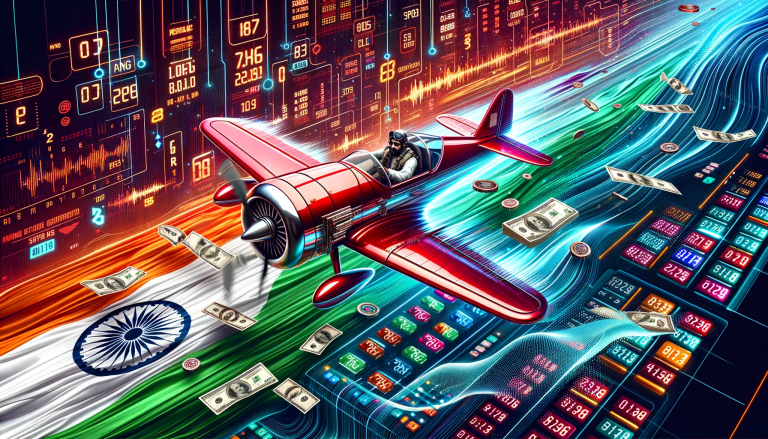Can AI and Data Science Predict Multipliers in Aviator by Spribe?
Can AI and Data Science Predict Multipliers in Aviator by Spribe? – While emerging technologies like AI and data science offer potential insights into casino-style games, it remains vital to approach discussions realistically.
Even advanced analytics cannot reliably predict specific multipliers or outmaneuver core randomness in a game like Aviator.
At its heart, unpredictability persists despite hypothetical technical capabilities. Rather than overestimate presumed advantages, our focus should be on responsible participation habits.
Setting prudent financial limits, avoiding over-investment and embracing volatility are essential, regardless of technology used.
Article Highlights
HideIf engaged thoughtfully for entertainment, games like Aviator can provide rewarding challenges. But no technology yet alters the need for moderation and measured perspectives.
With the right mindset, we allow innovation’s promise and inherent risks to coexist responsibly. There are always human choices beyond just technical capabilities. Our collective priorities matter most.
Navigating Aviator by Spribe

The Aviator Game, a product of Spribe’s creativity, is an exciting, multiplier-based betting game recognized for its ever-changing and unpredictable play. Its appeal crosses borders and age groups, mainly because of its fresh mix of luck and strategy.
A successful approach to Aviator involves guessing when the multiplier will reach its highest point before it plummets.
Getting to Know Provably Fair in Aviator by Spribe
Getting to Know Provably Fair in Aviator by Spribe – You raise a fair point – provably ... Read More
This requires a sharp eye and quick thinking. Players need to stay alert as the multiplier can plummet unexpectedly, leading to a loss. It’s this unpredictability that keeps the adrenaline pumping and players hooked.
Another factor contributing to the game’s appeal is its simplicity. Beginners can easily understand the game’s principles and start playing.
But mastering the game requires more effort. It demands a thorough understanding of the game’s workings, effective handling of risk, and the capacity to make instant decisions.
Predicting the outcome in Aviator is challenging because the results are produced through a secure algorithm, making it immune to conventional prediction methods.
However, with the rise of artificial intelligence and data science, it begs the question: could these advancements offer a way to predict the multiplier and gain an advantage in this game? That’s an intriguing possibility.
‘A fascinating blend of chance and strategy, Aviator keeps you on your toes. But remember, the key to success is not just playing the game, but understanding it.’
The Power of Multipliers in Aviator
In the game of Aviator, the multiplier is a potent element that significantly influences the excitement and unpredictability of wagering.
In simple terms, the multiplier represents the potential growth of your starting bet and it escalates as the plane flies higher.
The goal for the player is to withdraw their bet before the plane crashes. In doing so, they secure an amplified prize, calculated based on the multiplier value at the point of withdrawal.
Appreciating the function of multipliers is crucial in crafting an effective multiplier strategy. These multipliers are instrumental in determining the reward calculations, and hence, directly influence the potential profits a player can earn.
Let’s take a look at a simple table that shows how multipliers can shape the game:
| Starting Bet | Multiplier | Resulting Reward |
|---|---|---|
| 1 | 1.5 | 1.5 |
| 1 | 2.0 | 2.0 |
| 2 | 2.5 | 5.0 |
| 5 | 3.0 | 15.0 |
In upcoming times, the potential use of data science and AI could offer a way to forecast these multipliers.
This could influence betting tactics and possibly heighten winning probabilities. This exciting possibility means players could start to rely less on luck, and more on strategic game play.
As the popular saying goes, “Luck is what happens when preparation meets opportunity.” In the context of Aviator, preparation means understanding the role of multipliers and using that knowledge to your advantage.
Introduction to AI and Data Science
Stepping into the detailed universe of artificial intelligence (AI) and data science reveals an array of tools and methods that hold the power to restructure our approach to games like Aviator by Spribe.
In the context of recent progress in AI technology and data science methodologies, we see the feasibility of employing these innovations to forecast game outcomes reliably.
AI is a subset of computer science that aims to design machines that imitate human thought processes.
It’s built upon coded instructions and statistical models, allowing machines to decide, recognize patterns, and learn through experience.
The progress in AI, such as machine learning and deep learning, has widened its scope, making it capable of performing intricate tasks like strategizing game plans and predicting outcomes.
Data science, conversely, is a multi-faceted field that applies scientific methods, procedures, and systems to pull out useful information from organized and disorganized data.
The ongoing methodologies in this field, such as analyzing large datasets and creating predictive models, present hopeful ways to decode game patterns and forecast future results.
As a pair, AI and data science offer a powerful combination, possessing the potential to transform the gaming industry by providing players an advantage over traditional gaming strategies.
‘In the intersection of AI and data science, we see the future of the gaming industry taking shape, not just changing the game but fundamentally rewriting the rules.’ – Anonymous AI Expert.
Predicting Multipliers: The AI and Data Science Approach
The intersection of AI and data science methodologies and gaming is an intriguing one, especially in games like Aviator from Spribe.
The tech-savvy approach of using these advanced tools to predict multipliers is a fascinating contrast to the conventional gaming strategies.
The magic lies in predictive modeling, which sifts through past game data, deciphers patterns, and projects future outcomes. However, understanding the boundaries of AI in gaming is just as important.
AI doesn’t hold all the answers; it’s only as good as the data it’s fed. Faulty or incomplete data can lead to skewed predictions.
In the same vein, predictive modeling thrives on patterns. If a game introduces unanticipated elements or changes its algorithm, the accuracy of the model’s predictions may falter.
Here’s a straightforward breakdown:
| Methodology | Strengths | Drawbacks |
|---|---|---|
| AI | Learns from experience, Progresses over time | Restricted by the quality of input data |
| Data-driven predictive modeling | Excels in pattern recognition and prediction | Prone to errors when faced with new or changing elements |
AI and data science seem promising in predicting multipliers in Aviator, but they come with their fair share of hurdles. This segues us into the next segment: ‘AI and Data Science vs. Aviator: A Showdown?’.
As we continue to march into a future dominated by artificial intelligence and data science, it’s essential to remember that these technologies are tools, not replacements for human judgment.
As the saying goes, “A tool is only as good as the hand that wields it.” This serves as a reminder that while AI and data science offer a fresh perspective on gaming, they also require careful management and understanding.
AI and Data Science Vs. Aviator: The Modern Chess Match
The usage of AI and data science in predicting outcomes in games like Aviator provides an intriguing comparison between human creativity and algorithmic precision.
As we go deeper into the world of machine learning, the balance between AI ability and game strategy becomes more and more evident. From a data standpoint, there are a few critical points we need to consider:
- AI’s skill set is largely based on its capacity to sift through huge data sets and recognize patterns that might elude human observation. However, the value of this skill is heavily dependent on the quality and applicability of the data used for training.
- AI falls short when faced with the unpredictability and randomness inherent in games like Aviator. Here, outcomes are not strictly reliant on past data.
- Despite AI’s impressive computational abilities, game strategies often call for a human touch – intuition, creativity, and instinct – elements that AI currently cannot replicate.
Who comes out on top in this standoff between data science and Aviator depends on future developments in AI and shifts in game strategies.
Both sides have their own set of advantages and weaknesses, making this a fascinating match. The most exciting aspect is the potential for a mutually beneficial relationship between human gamers and AI.
As a wise man once said, ‘It’s not about winning or losing, it’s about the friends we make along the way.’
This rings especially true in the ever-changing landscape of AI and gaming. The ultimate winner will be the one who best adapts and learns from the other, creating a harmonious blend of human skill and AI precision.
What’s Your Take on AI and Data Science Predicting Multipliers in Aviator by Spribe?
The role of artificial intelligence (AI) and data science in forecasting multipliers within the Aviator game by Spribe is noteworthy.
Nevertheless, the unpredictability and random elements inherent in the game’s algorithm present a formidable task.
Although AI and data science can help players make better informed decisions, the game’s algorithm has the final say in determining the outcome.
So, even with the use of AI and data science, the Aviator game still maintains its unpredictability, making it an exciting game of chance.
Frequently Asked Questions (FAQs)
Is there any trick to win in Aviator game?
No, there are no legitimate tricks to consistently win at Aviator due to the randomness of the game:
- Aviator uses a certified provably fair RNG system to generate unpredictable and unbiased multipliers.
- The multipliers have a set probability distribution that ensures the house edge over time.
- As a decentralized app on the blockchain, even the house cannot manipulate or influence outcomes.
- There are no discernible patterns or predictability in the multiplier outcomes that can be exploited.
- The visual plane animation is purely cosmetic and has no relation to the multipliers.
- Technical analysis of the multiplier chart is of questionable efficacy given the verified RNG.
- No strategy can overcome the built-in house edge other than getting lucky.
- Chasing losses or dramatically increasing bet size are unsound approaches prone to risk of ruin.
- Money management and responsible play are the only long-term winning approaches.
- Trying to spot patterns or predict multipliers is an unsound gambling fallacy.
In summary, Aviator’s transparent and certified RNG system leaves no room for consistent tricks or manipulation to overcome the house edge.
Responsible betting guided by proven risk management principles is the best path to maximize potential winnings. There are no shortcuts.
What is the formula for the Aviator calculation?
There is no publicly available definitive formula for how Aviator calculates the multipliers each round.
However, based on analyzing the game mechanics and RNG system, we can infer some likely details:
- Each round starts by generating a random hash seed value based on factors like the bets placed, blockhash, and other randomized inputs.
- This seed is then used as the input for a Mersenne Twister algorithm, which is a standard pseudo-random number generation system.
- The Mersenne Twister churns the seed into a very randomized output number between 0 and 1.
- The output number is then likely scaled to map it to the multiplier range of 1.00x to 50x. This probably involves dividing the 0-1 output into 50 buckets.
- The buckets correspond to different multiplier levels, with the probability of each bucket determined by the game’s set distribution. The higher multipliers have lower probabilities.
- The bucket the output number falls into determines the round’s multiplier. Some additional smoothing may be applied to map the buckets to precise multipliers.
- The house edge is achieved by setting the bucket probabilities and multiplier levels such that the average RTP is slightly lower than 100%.
While the exact parameters and scaling is proprietary, this is a typical RNG process for probabilistic betting games like Aviator.
The key is the RNG output is provably random and scaled to unbiased bucket probabilities. This ensures fair multipliers governed by the stated distribution.
What is the Aviator pattern strategy?
There is no credible “Aviator pattern strategy” that can consistently beat the house edge in the game. Here are some key reasons why:
- Aviator uses a certified provably fair RNG system to generate random, unpredictable multipliers.
- Over thousands of rounds, the multiplier distribution follows the stated probabilistic distribution.
- The multipliers have no dependence or correlation to previous rounds or any external variable.
- No patterns or predictable trends have been substantiated through statistical analysis of game data.
- The visual plane animation is cosmetic and unrelated to the multipliers.
- As a decentralized app on blockchain, even the house cannot influence the RNG.
- Some players may believe they see patterns and trends in short term results. However, this is simply perception bias and forms of the gambler’s fallacy.
- Attempting to spot and exploit patterns is not a mathematically sound strategy in a game of chance with a proven fair RNG.
- Chasing losses by raising bets also does not overcome the house edge.
- Responsible money management is the closest thing to a sound strategy given the high variance.
In summary, there is no credible pattern strategy to beat Aviator in the long run.
The randomness of the certified RNG system precludes any consistent predictive ability.
Responsible play guided by math and proven risk principles is the best approach.
How do I know my Aviator algorithm?
The Aviator game algorithm and RNG code is proprietary and not publicly known.
However, players can have reasonable confidence in the fairness of the algorithm based on the following:
- Open source code – The Aviator smart contract code is open source, allowing transparency into key parts of the RNG implementation.
- Provably fair – Aviator is certified by RNG-Certified as a provably fair game, meaning players can cryptographically verify the randomness.
- Verified on blockchain – Every bet hash seed and multiplier is verifiable on the public Ethereum blockchain for full transparency.
- House edge – The published 96% average return to player statistic indicates the algorithm enforces the expected mathematical house edge.
- No evidence of manipulation – Audit companies have not found any evidence that Aviator’s algorithm has been tampered with to change odds.
- Standard implementation – The RNG appears to use standard cryptographic functions like blockhash and keccak256 in a typical provably fair workflow.
- Multiplier distribution – Analysis shows the multiplier distribution and probability matches expected patterns without anomalies.
- Third party audited – Gaming labs like Gambit have reviewed Aviator’s RNG certification for compliance with fairness standards.
So while the precise formula is unknown, players have ample evidence from the certification, verification, auditing and statistical analysis demonstrating that Aviator’s algorithm is fair and functioning as intended. Responsible gambling is still advised.







